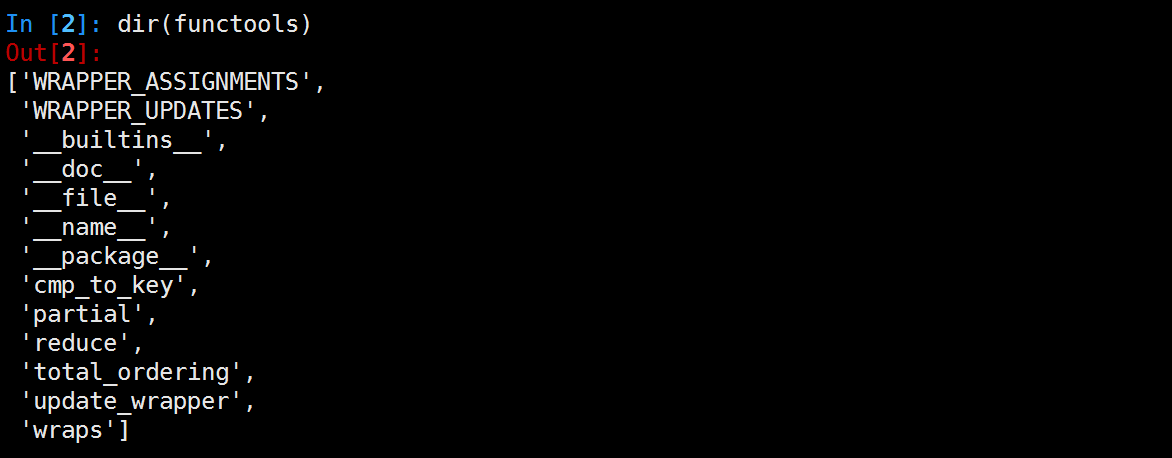内建函数
Build-in Function,启动python解释器,输入dir(__builtins__), 可以看到很多python解释器启动后默认加载的属性和函数,这些函数称之为内建函数, 这些函数因为在编程时使用较多,cpython解释器用c语言实现了这些函数,启动解释器 时默认加载。
这些函数数量众多,不宜记忆,开发时不是都用到的,待用到时再help(function), 查看如何使用,或结合百度查询即可,在这里介绍些常用的内建函数。
range
range(stop) -> list of integers
range(start, stop[, step]) -> list of integers
- start:计数从start开始。默认是从0开始。例如range(5)等价于range(0, 5);
- stop:到stop结束,但不包括stop.例如:range(0, 5) 是[0, 1, 2, 3, 4]没有5
- step:每次跳跃的间距,默认为1。例如:range(0, 5) 等价于 range(0, 5, 1)
python2中range返回列表,python3中range返回一个迭代值。如果想得到列表,可通过list函数
a = range(5)
list(a)
创建列表的另外一种方法
In [21]: testList = [x+2 for x in range(5)]
In [22]: testList
Out[22]: [2, 3, 4, 5, 6]
map函数
map函数会根据提供的函数对指定序列做映射
map(...)
map(function, sequence[, sequence, ...]) -> list
- function:是一个函数
- sequence:是一个或多个序列,取决于function需要几个参数
- 返回值是一个list
参数序列中的每一个元素分别调用function函数,返回包含每次function函数返回值的list。
#函数需要一个参数
map(lambda x: x*x, [1, 2, 3])
#结果为:[1, 4, 9]
#函数需要两个参数
map(lambda x, y: x+y, [1, 2, 3], [4, 5, 6])
#结果为:[5, 7, 9]
def f1( x, y ):
return (x,y)
l1 = [ 0, 1, 2, 3, 4, 5, 6 ]
l2 = [ 'Sun', 'M', 'T', 'W', 'T', 'F', 'S' ]
l3 = map( f1, l1, l2 )
print(list(l3))
#结果为:[(0, 'Sun'), (1, 'M'), (2, 'T'), (3, 'W'), (4, 'T'), (5, 'F'), (6, 'S')]
filter函数
filter函数会对指定序列执行过滤操作
filter(...)
filter(function or None, sequence) -> list, tuple, or string
Return those items of sequence for which function(item) is true. If
function is None, return the items that are true. If sequence is a tuple
or string, return the same type, else return a list.
- function:接受一个参数,返回布尔值True或False
- sequence:序列可以是str,tuple,list
filter函数会对序列参数sequence中的每个元素调用function函数,最后返回的结果包含调用结果为True的元素。
返回值的类型和参数sequence的类型相同
返回值的类型和参数sequence的类型相同
filter(lambda x: x%2, [1, 2, 3, 4])
[1, 3]
filter(None, "she")
'she'
reduce函数
reduce函数,reduce函数会对参数序列中元素进行累积
reduce(...)
reduce(function, sequence[, initial]) -> value
Apply a function of two arguments cumulatively to the items of a sequence,
from left to right, so as to reduce the sequence to a single value.
For example, reduce(lambda x, y: x+y, [1, 2, 3, 4, 5]) calculates
((((1+2)+3)+4)+5). If initial is present, it is placed before the items
of the sequence in the calculation, and serves as a default when the
sequence is empty.
- function:该函数有两个参数
- sequence:序列可以是str,tuple,list
- initial:固定初始值
reduce依次从sequence中取一个元素,和上一次调用function的结果做参数再次调用function。 第一次调用function时,如果提供initial参数,会以sequence中的第一个元素和initial 作为参数调用function,否则会以序列sequence中的前两个元素做参数调用function。 注意function函数不能为None。
reduce(lambda x, y: x+y, [1,2,3,4])
10
reduce(lambda x, y: x+y, [1,2,3,4], 5)
15
reduce(lambda x, y: x+y, ['aa', 'bb', 'cc'], 'dd')
'ddaabbcc'
在Python3里,reduce函数已经被从全局名字空间里移除了, 它现在被放置在fucntools模块里用的话要先引入:
from functools import reduce
sorted函数
sorted(...)
sorted(iterable, cmp=None, key=None, reverse=False) --> new sorted list

集合set
集合与之前列表、元组类似,可以存储多个数据,但是这些数据是不重复的
集合对象还支持union(联合), intersection(交), difference(差)和sysmmetric_difference(对称差集)等数学运算.
>>> x = set('abcd')
>>> x
{'c', 'a', 'b', 'd'}
>>> type(x)
<class 'set'>
>>>
>>>
>>> y = set(['h','e','l','l','o'])
>>> y
{'h', 'e', 'o', 'l'}
>>>
>>>
>>> z = set('spam')
>>> z
{'s', 'a', 'm', 'p'}
>>>
>>>
>>> y&z #交集
set()
>>>
>>>
>>> x&z #交集
{'a'}
>>>
>>>
>>> x|y #并集
{'a', 'e', 'd', 'l', 'c', 'h', 'o', 'b'}
>>>
>>> x-y #差集
{'c', 'a', 'b', 'd'}
>>>
>>>
>>> x^z #对称差集(在x或z中,但不会同时出现在二者中)
{'m', 'd', 's', 'c', 'b', 'p'}
>>>
>>>
>>> len(x)
4
>>> len(y)
4
>>> len(z)
4
>>>
functools
functools 是python2.5被引人的,一些工具函数放在此包里。
python2.7中

python3.5中
import functools
dir(functools)
运行结果:
['MappingProxyType',
'RLock',
'WRAPPER_ASSIGNMENTS',
'WRAPPER_UPDATES',
'WeakKeyDictionary',
'_CacheInfo',
'_HashedSeq',
'__all__',
'__builtins__',
'__cached__',
'__doc__',
'__file__',
'__loader__',
'__name__',
'__package__',
'__spec__',
'_c3_merge',
'_c3_mro',
'_compose_mro',
'_convert',
'_find_impl',
'_ge_from_gt',
'_ge_from_le',
'_ge_from_lt',
'_gt_from_ge',
'_gt_from_le',
'_gt_from_lt',
'_le_from_ge',
'_le_from_gt',
'_le_from_lt',
'_lru_cache_wrapper',
'_lt_from_ge',
'_lt_from_gt',
'_lt_from_le',
'_make_key',
'cmp_to_key',
'get_cache_token',
'lru_cache',
'namedtuple',
'partial',
'partialmethod',
'reduce',
'singledispatch',
'total_ordering',
'update_wrapper',
'wraps']
python3中增加了更多工具函数,做业务开发时大多情况下用不到,此处介绍使用频率较高的2个函数。
partial函数(偏函数)
把一个函数的某些参数设置默认值,返回一个新的函数,调用这个新函数会更简单。
import functools
def showarg(*args, **kw):
print(args)
print(kw)
p1=functools.partial(showarg, 1,2,3)
p1()
p1(4,5,6)
p1(a='python', b='itcast')
p2=functools.partial(showarg, a=3,b='linux')
p2()
p2(1,2)
p2(a='python', b='itcast')

wraps函数
使用装饰器时,有一些细节需要被注意。例如,被装饰后的函数其实已经是另外一个函数了(函数名等函数属性会发生改变)。
添加后由于函数名和函数的doc发生了改变,对测试结果有一些影响,例如:
def note(func):
"note function"
def wrapper():
"wrapper function"
print('note something')
return func()
return wrapper
@note
def test():
"test function"
print('I am test')
test()
print(test.__doc__)
运行结果
note something
I am test
wrapper function
所以,Python的functools包中提供了一个叫wraps的装饰器来消除这样的副作用。例如:
import functools
def note(func):
"note function"
@functools.wraps(func)
def wrapper():
"wrapper function"
print('note something')
return func()
return wrapper
@note
def test():
"test function"
print('I am test')
test()
print(test.__doc__)
运行结果
note something
I am test
test function